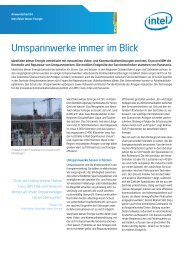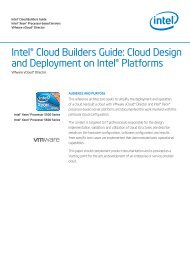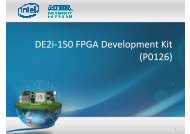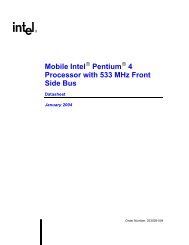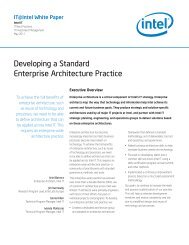Intel® PRO/1000 PT and PF Quad Port Bypass Server Adapters for ...
Intel® PRO/1000 PT and PF Quad Port Bypass Server Adapters for ...
Intel® PRO/1000 PT and PF Quad Port Bypass Server Adapters for ...
- No tags were found...
You also want an ePaper? Increase the reach of your titles
YUMPU automatically turns print PDFs into web optimized ePapers that Google loves.
Technology Brief Intel® <strong>PRO</strong>/<strong>1000</strong> <strong>PT</strong> <strong>and</strong> <strong>PF</strong> <strong>Quad</strong> <strong>Port</strong> <strong>Bypass</strong> <strong>Server</strong> <strong>Adapters</strong> <strong>for</strong> In-line <strong>Server</strong> AppliancesIntrusion Prevention <strong>Server</strong>s <strong>and</strong>Business ContinuityCyber attacks on enterprise networks continue to increasein variety, frequency, <strong>and</strong> intensity. Worms, viruses, Trojanhorses, denial of service (DoS), identity theft, <strong>and</strong> otherattacks cost businesses worldwide an estimated USD 100billion annually. As a result, enterprises are becomingincreasingly proactive in combating cyber attacks. In turn,this has led to an increased dem<strong>and</strong> <strong>for</strong> the protectiveadvantages of network integrated security appliances(ISAs), particularly those that deal with attacks be<strong>for</strong>ethey even enter the network.Increasingly, enterprises are turning to ISAs that arespecialized security servers located at the networkgateway to stop attacks at the network edge. One classof such servers is the intrusion detection server (IDS).An IDS sits at the edge of the network or at criticalsubsegments <strong>and</strong> monitors all network traffic <strong>for</strong>anomalous data conditions indicating a possible attack.A more proactive approach, however, is the intrusionprevention server (IPS), which not only detects but alsoblocks or prevents intrusions. Even more recently, securitybegan moving to the network core with internal securitygateways to prevent attacks from inside the network.Rather than residing to the side of the network on a spanor tap like an IDS, an IPS resides in line with the network’scritical path (see Figure 1). This allows the IPS to monitorall network traffic flow <strong>and</strong> to detect <strong>and</strong> block trafficanomalies in real time using Layer 2 through Layer 7signature-based <strong>and</strong> protocol-based analysis.From a network per<strong>for</strong>mance viewpoint, the key concernswith the IPS approach are its in-line <strong>and</strong> real-timerequirements. To be real-time or near real-time, the IPSnetwork connection must have high b<strong>and</strong>width <strong>and</strong>minimum latency. Moreover, because it is in line with thecritical path, the IPS must be able to fail safely; otherwise,an IPS failure or instability could bring down the entirenetwork. To address these concerns, Intel has designed afamily of Gigabit Ethernet (GbE) quad port bypass serveradapters specifically <strong>for</strong> intrusion prevention servers <strong>and</strong>other in-line appliances. These server adapters—the Intel®<strong>PRO</strong>/<strong>1000</strong> <strong>PT</strong> <strong>Quad</strong> <strong>Port</strong> <strong>Bypass</strong> <strong>Server</strong> Adapter <strong>for</strong>Intel® <strong>PRO</strong>/<strong>1000</strong> <strong>PT</strong>Dual <strong>Port</strong><strong>Server</strong> AdapterIntel® <strong>PRO</strong>/<strong>1000</strong> <strong>PT</strong>Dual <strong>Port</strong><strong>Server</strong> AdapterIntel® <strong>PRO</strong>/<strong>1000</strong> <strong>PT</strong> <strong>Quad</strong> <strong>Port</strong><strong>Bypass</strong> <strong>Server</strong> Adapter (<strong>for</strong> fiber)orIntel® <strong>PRO</strong>/<strong>1000</strong> <strong>PF</strong> <strong>Quad</strong> <strong>Port</strong><strong>Bypass</strong> <strong>Server</strong> Adapter (<strong>for</strong> copper)DepartmentWorkgroup<strong>Server</strong>sIntrusionPrevention<strong>Server</strong>WorkgroupSwitchWorkgroupSwitchThe WANOutside InternetConnectionRouterDepartmentWorkgroup<strong>Server</strong>sIntel® <strong>PRO</strong>/<strong>1000</strong> <strong>PT</strong>Dual <strong>Port</strong><strong>Server</strong> AdapterIntel® <strong>PRO</strong>/<strong>1000</strong> <strong>PT</strong>Dual <strong>Port</strong><strong>Server</strong> AdapterFigure 1. Intel® <strong>PRO</strong>/<strong>1000</strong> <strong>PT</strong> <strong>and</strong> <strong>PF</strong> <strong>Quad</strong> <strong>Port</strong> <strong>Bypass</strong> <strong>Server</strong> <strong>Adapters</strong> provide high-per<strong>for</strong>mance, fail-safe Gigabit Ethernetconnectivity <strong>for</strong> intrusion prevention servers.3
Figure 2 further illustrates this bypass operation. The topillustration shows a pair of ports on the Intel <strong>PRO</strong>/<strong>1000</strong><strong>PF</strong> <strong>Quad</strong> <strong>Port</strong> <strong>Bypass</strong> <strong>Server</strong> Adapter operating in thenormal in-line mode, <strong>and</strong> the illustration on the bottomshows the adapter switches in bypass mode. The bypasscircuit operates even in the absence of power so that thenetwork connection is always maintained, even with theserver powered down. Additionally, IT managers canprogram bypass mode to enable it <strong>for</strong> testing or to disableit to turn the adapter into a st<strong>and</strong>ard GbE server adapter.PCI Express, <strong>Quad</strong> <strong>Port</strong> GbE Connectivity<strong>for</strong> Higher B<strong>and</strong>widthUse of a quad port GbE adapter <strong>for</strong> any server—<strong>and</strong>especially IPSs—is particularly advantageous. <strong>Quad</strong> portPCI Express (PCIe) server adapters provide four networkconnections from a single server slot, thus conservingserver slots <strong>for</strong> other applications while taking full advantageof the b<strong>and</strong>width provided by the new PCIe x4 slots. Justas important, the multiple GbE ports allow traffic capacityto be increased through various techniques, includingteamed links or ports <strong>and</strong> network segmentation.In the case of an IPS, at least two ports are required tosupport IPS in-line operation. One port provides the“outside” connection to the network or segment edge.Traffic from this outside port passes into the IPS <strong>and</strong> theIPS analyzes the traffic <strong>for</strong> anomalous conditions. Thesanitized traffic then passes from the IPS through thesecond, “inside” port to the network under IPS prevention.In the case of the Intel <strong>PRO</strong>/<strong>1000</strong> <strong>PT</strong> <strong>and</strong> <strong>PF</strong> <strong>Quad</strong> <strong>Port</strong><strong>Bypass</strong> <strong>Server</strong> <strong>Adapters</strong>, four ports are provided. There aretwo “outside” ports <strong>and</strong> two corresponding “inside” ports.This allows essentially a doubling of GbE traffic capacityby allowing the IPS to protect two links or networksegments at once. This is illustrated in Figure 1, whereone IPS receives incoming traffic off two links from therouter <strong>and</strong> passes the “protected” traffic to two differentworkgroup switches.To help ensure availability of the full b<strong>and</strong>width potentialof GbE connectivity, the Intel <strong>PRO</strong>/<strong>1000</strong> <strong>PT</strong> <strong>and</strong> <strong>PF</strong> <strong>Quad</strong><strong>Port</strong> <strong>Bypass</strong> <strong>Server</strong> <strong>Adapters</strong> use the PCIe architecture <strong>for</strong>server I/O, rather than the PCI or PCI-X bus. As opposed tothe PCI or PCI-X shared, multi-drop, parallel-bus structure,the PCIe interface is a dedicated point-to-point serial buswith a unidirectional raw b<strong>and</strong>width of 2.5 Gigabits per
Technology Brief Intel® <strong>PRO</strong>/<strong>1000</strong> <strong>PT</strong> <strong>and</strong> <strong>PF</strong> <strong>Quad</strong> <strong>Port</strong> <strong>Bypass</strong> <strong>Server</strong> <strong>Adapters</strong> <strong>for</strong> In-line <strong>Server</strong> Appliancessecond (Gbps) <strong>for</strong> a x1 (“by one”) bus lane. The Intel<strong>PRO</strong>/<strong>1000</strong> <strong>PT</strong> <strong>and</strong> <strong>PF</strong> <strong>Quad</strong> <strong>Port</strong> <strong>Bypass</strong> <strong>Server</strong> <strong>Adapters</strong>are scaled up to x4 PCIe lanes, providing four times thebus b<strong>and</strong>width of a single (x1) PCIe lane.Also, PCIe lanes are bi-directional: a transmit path <strong>and</strong> areceive path allow simultaneous transmission <strong>and</strong>reception. In contrast, PCI <strong>and</strong> PCI-X are limited to eithertransmitting or receiving at any given time, which injectslatency when a transmit process is <strong>for</strong>ced to wait <strong>for</strong>a receive process to complete be<strong>for</strong>e transmitting.Such latency does not occur with PCIe because it isbi-directional, <strong>and</strong> the adapter does not have to contendwith other devices <strong>for</strong> the bus.Another feature critical to in-line appliances is the abilityto h<strong>and</strong>le the full traffic flow of the network withoutadding latency, especially <strong>for</strong> the small data packetstypical of network front ends. To verify capability <strong>for</strong> this,Intel tested the new Intel® 82571GB Gigabit EthernetController used in the Intel <strong>PRO</strong> <strong>Quad</strong> <strong>Port</strong> <strong>Bypass</strong> <strong>Server</strong><strong>Adapters</strong> with a special hardware per<strong>for</strong>mance driver ina stackless loop-back mode. At 64-byte packets <strong>and</strong>larger, Intel measured on both ports simultaneously a fullbi-directional wire-speed line rate (measured as packetsper second) <strong>and</strong> bit-stream <strong>and</strong> payload throughputs up tothe theoretical maximum. This gives the Intel <strong>PRO</strong>/<strong>1000</strong><strong>PT</strong> <strong>and</strong> <strong>PF</strong> <strong>Quad</strong> <strong>Port</strong> <strong>Bypass</strong> <strong>Server</strong> <strong>Adapters</strong> thepotential <strong>for</strong> providing the best possible small-packethardware per<strong>for</strong>mance <strong>for</strong> optimizing in-line applianceapplications.Intel® I/O Acceleration Technology MovesNetwork Data More EfficientlyThe Intel <strong>PRO</strong>/<strong>1000</strong> <strong>PT</strong> <strong>and</strong> <strong>PF</strong> <strong>Quad</strong> <strong>Port</strong> <strong>Bypass</strong> <strong>Server</strong><strong>Adapters</strong> also incorporate the new Intel I/OAT. Intel I/OATis an evolving plat<strong>for</strong>m-wide technology that movesnetwork data more efficiently through Dual-Core IntelXeon processor-based servers <strong>for</strong> fast, scalable, <strong>and</strong>reliable networking. It improves network applicationresponsiveness by unleashing the power of Intel Xeonprocessors through more efficient network datamovement <strong>and</strong> reduces system overhead, plus it scalesseamlessly across multiple Ethernet ports.Intel I/OAT addresses all segments of the server I/Obottleneck problem <strong>and</strong> does it by using TCP/IP withoutrequiring any modification of existing or futureapplications. The system-wide network I/O accelerationtechnologies applied by Intel I/OAT are summarized inFigure 3 <strong>and</strong> include network flow affinity, asynchronouslow-cost copy, <strong>and</strong> improved TCP/IP protocol with anoptimized TCP/IP stack.In the Intel <strong>PRO</strong>/<strong>1000</strong> <strong>PT</strong> <strong>and</strong> <strong>PF</strong> <strong>Quad</strong> <strong>Port</strong> <strong>Bypass</strong> <strong>Server</strong><strong>Adapters</strong>, Intel I/OAT is supported through packet-orientedroutines that provide header splitting <strong>and</strong> interruptmoderation. Header splitting separates the TCP/IP packetheader <strong>and</strong> payload <strong>for</strong> faster processing of each onseparate, parallel paths. Interrupt moderation collectsinterrupts at the adapter <strong>and</strong> only interrupts the CPU toh<strong>and</strong>le a larger set of packets at a time.Optimized TCP/IPprotocol stack withenhancements<strong>Server</strong> with Intel® I/O Acceleration TechnologyBalanced networkprocessing on multipleCPUs with networkflow affinityEnhanced direct memoryaccess with asynchronouslow-cost copyNetworkData StreamFigure 3. Intel® I/OAT moves network data more efficiently through Dual-Core Intel® Xeon® processor-based servers.6
Technology Brief Intel® <strong>PRO</strong>/<strong>1000</strong> <strong>PT</strong> <strong>and</strong> <strong>PF</strong> <strong>Quad</strong> <strong>Port</strong> <strong>Bypass</strong> <strong>Server</strong> <strong>Adapters</strong> <strong>for</strong> In-line <strong>Server</strong> AppliancesBoth header splitting <strong>and</strong> interrupt modulation provide <strong>for</strong>greater packet h<strong>and</strong>ling efficiency through the adapter.The result is greater throughput, <strong>and</strong> this can be furtheramplified when Intel <strong>PRO</strong>/<strong>1000</strong> <strong>PT</strong> <strong>and</strong> <strong>PF</strong> <strong>Quad</strong> <strong>Port</strong><strong>Bypass</strong> <strong>Adapters</strong> are used with the Intel I/OAT capabilitiesof Dual-Core Intel Xeon processor-based servers.NIC-in-Front Access to LAN I/O <strong>Port</strong>sBecause of the critical nature of IPS <strong>and</strong> other in-lineappliances to the enterprise network, IT managers mayper<strong>for</strong>m frequent monitoring of the NIC I/O ports. To makethis easier, bypass adapter versions are available with NIFaccess to the LAN I/O ports. NIF provides a front-panelconnector <strong>and</strong> the corresponding light-emitting diode(LED) <strong>and</strong> cable assemblies to allow port access <strong>and</strong> LEDdisplays at the front of the server, while the adapterremains in the rear of the chassis in a st<strong>and</strong>ardmotherboard.These new adapters are the world’s first native PCIe quadport bypass adapters, <strong>and</strong> they join a long line of Intelfirsts in NIC technology, including the world’s first 10 GbEadapter. Like all of the GbE adapters in Intel’s broadproduct line, the Intel <strong>PRO</strong>/<strong>1000</strong> <strong>PT</strong> <strong>and</strong> <strong>PF</strong> <strong>Quad</strong> <strong>Port</strong><strong>Bypass</strong> <strong>Server</strong> <strong>Adapters</strong> are supported by open-sourcedrivers that reflect the extensive engagement Intelmaintains with the open-source community. In fact, OpenSource Linux* <strong>and</strong> FreeBSD* reference drivers are availableon request <strong>for</strong> integration into your solution.For more in<strong>for</strong>mation on Intel® <strong>PRO</strong>/<strong>1000</strong> <strong>PT</strong><strong>and</strong> <strong>PF</strong> <strong>Quad</strong> <strong>Port</strong> <strong>Bypass</strong> <strong>Server</strong> <strong>Adapters</strong> <strong>for</strong>in-line server appliances, contact your IntelSales Representative or visitwww.intel.com/go/bypassadaptersSafe <strong>and</strong> Easy IPS ConnectivityThe Intel <strong>PRO</strong>/<strong>1000</strong> <strong>PT</strong> <strong>and</strong> <strong>PF</strong> <strong>Quad</strong> <strong>Port</strong> <strong>Bypass</strong> <strong>Server</strong><strong>Adapters</strong> provide safe <strong>and</strong> easy in-line applianceconnectivity, because they are designed to meet in-lineappliance needs with multiple GbE ports <strong>for</strong> in-lineconnectivity <strong>and</strong> a fail-safe bypass mode. Additionally,these adapters supersede PCI <strong>and</strong> PCI-X with the muchfaster third-generation PCIe serial bus <strong>for</strong> greaterthroughput, <strong>and</strong> they use Intel I/OAT <strong>for</strong> furtherper<strong>for</strong>mance enhancement, including the reducedoverhead so important to IPS applications.7
Copyright 2006 Intel Corporation. All rights reserved. Intel, the Intel logo,©Intel. Leap ahead. <strong>and</strong> Intel. Leap ahead. logo, <strong>and</strong> Xeon are trademarks orregistered trademarks of Intel Corporation or its subsidiaries in the UnitedStates <strong>and</strong> other countries.*Other names <strong>and</strong> br<strong>and</strong>s may be claimed as the property of others.Printed in USA 0606/BY/PMS/PP/1KOrder Number: 313587-001US



